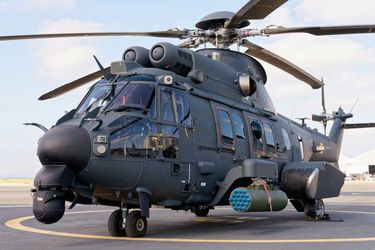The nature of warfare is changing, so it naturally follows that militaries will require new capacities in order to adapt to emergent threats, in addition to their more traditional support roles. In 2023, Hungary took delivery of the first H225M with HForce. Phillipe Kohn, Military Missions Specialist for Airbus Helicopters explains why it makes sense to add weapons to a heavy helicopter.

An evolving war needs an evolving helicopter
“Tomorrow’s war will be a hybrid war,” states Philippe Kohn, as he explains that multi-faceted threats will necessitate a range of responses. “It won’t be the case of two armies fighting each other, it’s two societies trying to destabilise one another. Cyber-attacks, attacks on energy supply, population displacement... starting fires all over the place. That’s what war is now. Militaries will need a helicopter that can perform a range of functions: rescue civilians, evacuate people, carry generators to repair energy systems that may have been attacked.”
Of course, militaries also regularly need a helicopter that is an effective firing platform. Historically, air support missions might have been more likely to be the domain of smaller helicopters with their superior discretion and agility. Often heavy helicopters weren’t even equipped with weapons, consigned to troop transport and utility missions. However, by adding armaments to the H225M, its mission scope can be significantly enlarged, theoretically rendering any weaponised mission possible – and whilst maintaining the superior range and payload of a heavy helicopter.
In short, now it can do everything. With the integration of HForce, the H225M has evolved into a completely versatile helicopter, capable of delivering any military mission. As Kohn explains, “HForce transforms a non-specialised helicopter into a non-specialised attack helicopter. Why? Because in order to fire, you have to aim, and to fire with precision, a specialised attack helicopter like the Tiger aims via the electro-optical system (EOS), and that didn’t exist [on a non-specilaised helicopter] until the development of HForce.”
Right on target
Kohn also points out that incorporating this enhanced versatility is in its own way, an innovative leap forward. “If a helicopter is powerful and if it reduces workload, which is definitely the case with the H225 – it was the first modern helicopter built for modern times, with autopilot, four-axis digital system – if we put good equipment and/or good weapons on this helicopter, it will have even more versatility. If I fire with a laser guided rocket from the H225M or from a Tiger, the end result will be the same. If you compare the cannon of a Tiger with the cannon of the H225M, there is a difference in terms of end result and mass, but we’re the only company that has been able to integrate a weapon this powerful into a non-specialised helicopter.”
The quality that the HForce system added to the H225M was immediately apparent during testing, with the helicopter’s size and flight controls giving it tremendous advantages as a firing platform, according to Kohn. “It’s excellent, it’s highly stable, our firing was extremely successful. It’s really very, very precise. With the non-guided rocket at 1,200 metres, we achieved a precision of less than 30 metres. It’s a helicopter capable of firing ballistic weapons of 20 millimetres – that’s the largest you can find in non-specialised helicopters; like with the rocket, the levels of ballistic precision are unparalleled.”

Role reversal
In addition to the helicopter’s enhanced versatility is the fact that it can be modified to switch roles extremely quickly. “In less than half an hour,” mentions Kohn, “with fewer than three technicians and with no special tools, you can transform an attack helicopter into a firefighting helicopter, a search and rescue helicopter, and I think ours is pretty much the only range that can offer this.”
Latest Helicopters news
Continue Reading

Spanish Ministry of Defence orders 100 Airbus helicopters
Press Release
Helicopters
Spain is placing orders for 100 Airbus helicopters through the Directorate General for Armament and Material (DGAM) of the Ministry of Defence.
German Navy takes over first NH90 Sea Tiger
Press Release
Helicopters

Germany orders 20 additional Airbus H145M helicopters
Press Release
Helicopters

Greece signs NH90 follow on support contract
Press Release
Helicopters

Airbus to onboard Artificial Intelligence in French armed forces' information systems
Press Release
Defence

